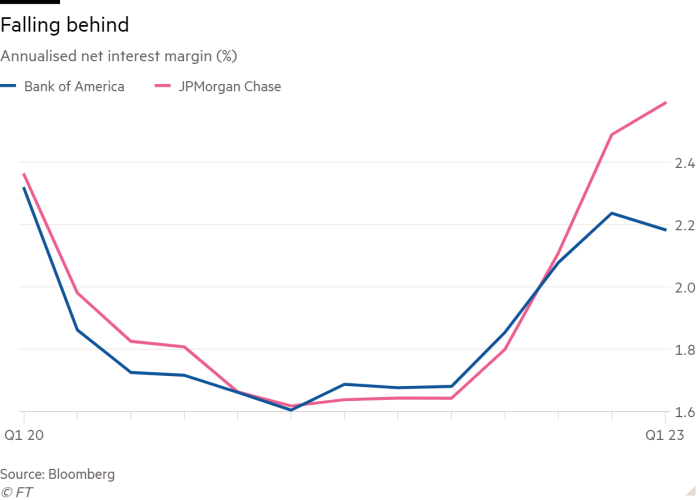Bank of America is currently facing the consequences of decisions made three years ago. During the pandemic, the bank put the majority of its $670 billion in deposit inflows into debt markets when bond prices were high and yields were low. As a result, Bank of America ended the first quarter with over $100 billion in paper losses, surpassing the losses reported by its largest competitors.
This disparity in losses is due to the differing strategies employed by banks during the early stages of the pandemic. Bank of America invested more in bonds, while others allocated a larger portion to cash. Now that bond yields have risen and prices have fallen, Bank of America’s portfolio value has plummeted. In contrast, JPMorgan Chase and Wells Fargo had approximately $40 billion in unrealized bond market losses, while Citigroup’s losses were $25 billion.
The losses incurred by Bank of America accounted for one-fifth of the total unrealized losses in securities portfolios among the country’s nearly 4,600 banks at the end of the first quarter, according to data from the Federal Deposit Insurance Corporation.
Bank analyst Dick Bove commended Bank of America CEO Brian Moynihan’s handling of the bank’s operations but criticized the state of the bank’s balance sheet.
Bank of America has no plans to sell its underwater bonds in order to avoid crystallized losses. The bank holds highly rated government-backed securities that are likely to be repaid upon maturity of the underlying loans. However, retaining these low-yielding investments, many of which are backed by 30-year home loans, while newly purchased bonds offer higher yields could limit the bank’s income from customer deposits.
Barclays bank analyst Jason Goldberg emphasized that the effectiveness of Bank of America’s bond portfolio is still uncertain. When interest rates were low, the bank made more money than its competitors. Now, the situation has reversed.
In recent years, banks, driven by low interest rates, increased regulation, and slow economic growth, have directed more deposits into bonds and other securities. The total value of securities held by all banks rose by 54% from the end of 2019 to mid-2022, outpacing the growth of their overall assets.
Bank of America, unlike Silicon Valley Bank, is not facing a liquidity crunch and currently has $370 billion in cash. Deposits from customers of regional lenders continue to flow into the bank. The bank’s bond holdings would regain value if interest rates were to fall again, as most home loans are paid off before their 30-year term.
Additionally, Bank of America performed well in the Federal Reserve’s stress tests, which were announced recently.
Nevertheless, the impact of Bank of America’s securities portfolio missteps is evident in its stock performance. The bank’s shares have fallen by 15% this year, making it the worst performer among its large competitors. In contrast, JPMorgan’s shares have gained 3%.
Furthermore, Bank of America’s net interest margin, a key measure of performance, is being negatively affected. JPMorgan has surpassed Bank of America in this regard, with a net interest margin of 2.6% compared to 2.2% at Bank of America.

According to banking analyst Scott Siefers, these unrealized losses are a concern for investors and have had a negative impact on the bank’s stock. When asked about the securities portfolio and potential losses, Bank of America’s CFO Alastair Borthwick stated that the bank is in the process of winding down its securities investments.
Borthwick, who became CFO in late 2021, is responsible for managing the bank’s securities holdings and overall balance sheet. The decision to invest in securities predates Borthwick’s role as CFO, with the unrealized losses on the portfolio being less than $1 billion at the time.
A source familiar with Moynihan’s thoughts stated that the securities losses have not affected succession planning or altered Moynihan’s plans to remain as CEO until the end of the decade. However, bank analyst Dick Bove believes that the handling of the securities portfolio will play a role in determining the next CEO and the timing of the transition.
The market is closely watching how Bank of America manages its securities portfolio, as the losses have impacted the bank financially and affected investor sentiment. Despite the challenges, the bank maintains a sizable cash reserve and has not experienced the liquidity issues faced by Silicon Valley Bank.
Bank of America’s net interest margin decrease is also a cause for concern, as it affects the bank’s profitability. In recent years, JPMorgan has outperformed Bank of America in this area. However, Bank of America’s performance in the Federal Reserve’s stress tests has been positive.
In summary, the impact of Bank of America’s securities portfolio decisions is evident in its financial results and stock performance. The bank’s management and handling of the situation will likely impact the selection of the next CEO. Despite the challenges, Bank of America remains well-positioned with its cash reserves and customer deposits.
The spokesperson for Bank of America declined to comment on the matter.
Denial of responsibility! VigourTimes is an automatic aggregator of Global media. In each content, the hyperlink to the primary source is specified. All trademarks belong to their rightful owners, and all materials to their authors. For any complaint, please reach us at – [email protected]. We will take necessary action within 24 hours.


